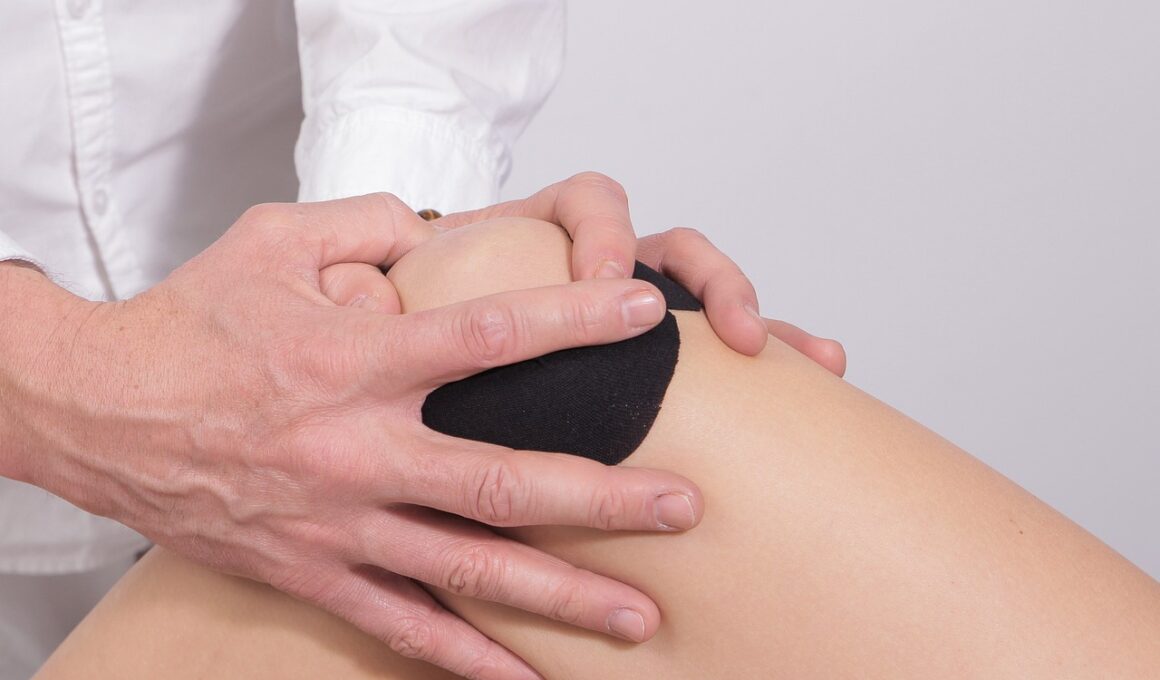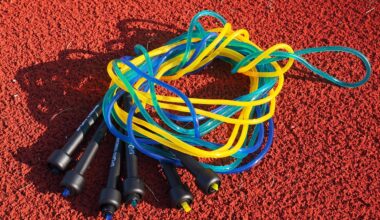The Effectiveness of Taping and Bracing Methods
In sports, injury prevention and management are vital for athletes to maintain peak performance. Taping and bracing methods are common techniques used to provide support and limit unnecessary movement of joints and muscles. These methods are particularly prevalent in sports where the risk of acute injuries is high, such as basketball and football. Taping typically involves applying adhesive tape around the affected area, while bracing utilizes a structured device designed to stabilize the joint or muscle. Both techniques aim to prevent injuries by limiting excessive range of motion and reducing loads on vulnerable body parts. Athletes often rely on these modalities during rehabilitation, as they assist with recovery and provide confidence in performance. Furthermore, it is important for athletes to receive guidance from professionals when utilizing these methods to ensure proper application and avoid complications. Research has indicated that both taping and bracing can reduce the incidence of injury, thereby enhancing overall athletic performance. Yet, the effectiveness of each method may vary based on individual circumstances and injury type, necessitating a tailored approach to injury management in sports settings.
Different types of taping techniques have been developed to cater to specific injuries and sports needs. Among these, elastic adhesive bandage taping and rigid taping are most common. Elastic taping allows for a full range of motion, making it suitable for muscular support, while rigid taping restricts joint movement, providing stability. Athletes benefit differently from these various techniques based on their sport. For instance, basketball players often use elastic taping for ankle support to enhance mobility, while football players may employ rigid taping for knee stabilization. However, the effectiveness of these techniques is heavily reliant on proper application, which necessitates training and experience. Professionals in sports medicine often guide athletes through appropriate taping techniques to ensure the desired benefit is achieved. Moreover, recent advancements in technology have led to the creation of Kinesiology tape, which offers benefits beyond traditional methods by stimulating blood flow and lymphatic drainage. The variety in taping methods highlights the importance of football-specific practices to effectively reduce injury risk and promote optimal recovery across different sports disciplines.
Bracing Techniques in Sports
Bracing techniques are equally important in sports injury prevention and management. Unlike taping, bracing involves a device that can be adjusted or customized to fit the athlete’s specific body shape and needs. These devices often consist of hard plastic or foam materials to provide a mechanical advantage, distributing forces away from the injured joint or muscle group. Braces are particularly effective for chronic conditions, such as ligament instability, patellar tendinitis, or post-surgical recovery. Athletes frequently find comfort and reassurance when wearing braces during practice and competitions, as they offer a heightened sense of security. Moreover, they can be used both during active gameplay or while recovering, aiding return-to-sport decisions. Various types of braces exist, including functional, prophylactic, and rehabilitative braces, each serving different purposes according to the injury nature. Additionally, braces offer extensive feedback during rehabilitation by closely monitoring how the athlete performs while wearing the device. Ultimately, both bracing and taping are effective strategies when used appropriately and tailored to the specific needs of individual athletes, contributing significantly to injury prevention strategies in sports.
Although the benefits of taping and bracing are significant, they are not without potential drawbacks. Athletes may experience discomfort, or skin irritation when using these methods, especially if the tape or brace is not applied correctly. Furthermore, there is a risk of dependency on external supports, which could potentially weaken the muscles or joints involved. Excessive reliance on these methods might lead to diminished proprioception, the body’s ability to sense movement, action, and location, making the athlete more susceptible to future injuries. It is essential for athletes to balance the use of these techniques with comprehensive strength training and rehabilitation exercises to ensure they maintain flexibility, balance, and strength. During rehabilitation, a gradual reintroduction to sport-specific movements without these supports can aid in rebuilding confidence and maintaining proper biomechanics. Education on the proper use of tape and braces is crucial for athletes, as is the integration with strength and conditioning programs to ensure a holistic approach to injury management. In conclusion, the benefits of taping and bracing techniques must be weighed against potential drawbacks, thus promoting responsible use in sports.
Conclusion: Personalization and Professional Guidance
In summary, the effectiveness of taping and bracing methods in sports injury prevention and management cannot be overstated. Athletes can benefit from enhanced stability, support, and confidence in their performance when these techniques are used correctly. Personalization is key in ensuring that each method fits the specific needs and circumstances of the athlete. Working closely with healthcare professionals ensures that athletes receive appropriate guidance tailored to their conditions. Regular training on proper techniques can help athletes minimize the risk of adverse effects, such as skin irritation or dependency on external supports. Furthermore, integrating both taping or bracing methods into a comprehensive rehabilitation program can lead to improved outcomes. Validation and research into these methods will continue to evolve, enabling sports medicine professionals to develop best practices based on updated knowledge and technology. The ultimate goal remains to empower athletes with the necessary tools and knowledge to prevent injuries and recover efficiently, enhancing their overall performance. As the sports landscape continues to change, the ongoing evaluation of these practices ensures that athletes can compete safely and confidently.
Future research on taping and bracing is crucial for advancing injury prevention techniques further. Investigating different taping methodologies, material properties, and the biomechanical effects of various bracing designs will enhance our understanding of injury mechanics. This understanding can lead to improved injury management protocols and optimized recovery timelines. Moreover, the evaluation of athlete feedback on comfort, stability, and performance is essential to refining these techniques. It will shed light on athletes’ preferences and experiences, ensuring innovative solutions align with their needs. Additionally, exploring the role of taping and bracing during different sports or positions can reveal tailored strategies for injury prevention. Studies that incorporate long-term effects and athlete performance feedback will provide a well-rounded perspective on the effectiveness of each method. As sports science develops, new technologies and advancements in materials will likely emerge, further optimizing injury prevention techniques. Ultimately, the goal remains to provide athletes with the best possible care, ensuring they can compete at high levels while minimizing the issue of injuries due to overuse or trauma.
Integrative Approaches to Injury Management
Integrating taping and bracing methods into a multi-faceted approach to injury management means considering physical therapy, strength training, and overall biomechanics. It is not enough to rely solely on these methods; athletes must also engage in proactive measures for sustaining healthy movement patterns. Strength training can help build the muscular support systems that stave off injuries, while physical therapy aids in restoring function post-injury. Additionally, sports nutrition plays a pivotal role in recovery, as proper nutrition aids in muscle repair and fitness. Maintaining a strong focus on biomechanics through training can help identify vulnerabilities athlete may have that predispose them to injuries. Implementing comprehensive injury prevention programs that include education on effective taping and bracing techniques, strength training, and injury monitoring can significantly improve athletes’ resilience. Furthermore, incorporating regular screenings can assist in identifying potential issues before they evolve into injuries. By fostering a culture of prevention and attentiveness among athletes, coaches, and practitioners, long-term success becomes achievable, ensuring athletes can remain competitive while reducing the likelihood of injury.
Ultimately, developing a better understanding of the effectiveness of the taping and bracing methods will pave the way for enhanced future practices in sports injury prevention. Collaboration among sports professionals, including coaches and athletic trainers, is essential to foster an environment conducive to injury-free training and competition. Engaging in ongoing research, education, and practice will not only promote athlete safety but also inspire overall performance improvements across sports disciplines. Athletes who embrace proactive measures while utilizing taping and bracing can achieve heightened performance and minimize injury risks significantly. Fostering a comprehensive approach to injury management allows athletes and professionals to flourish together, promoting a healthier, injury-free sporting environment. As the field of sports science continues to advance, ongoing exploration of the interplay between taping, bracing and injury prevention will remain both relevant and vital in shaping effective strategies and methods for the future. With continuous improvement and emphasis on injury prevention, the landscape of sports participation will grow safer and more effective.


